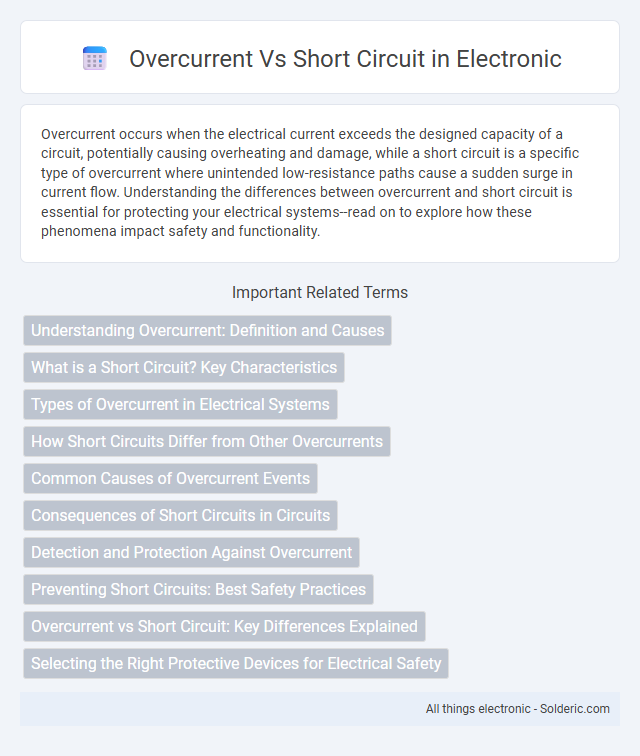Overcurrent occurs when the electrical current exceeds the designed capacity of a circuit, potentially causing overheating and damage, while a short circuit is a specific type of overcurrent where unintended low-resistance paths cause a sudden surge in current flow. Understanding the differences between overcurrent and short circuit is essential for protecting your electrical systems--read on to explore how these phenomena impact safety and functionality.
Comparison Table
| Aspect | Overcurrent | Short Circuit |
|---|---|---|
| Definition | Current exceeding the rated value of a circuit or component. | An unintended low-resistance connection causing excessive current flow. |
| Cause | Overload, device failure, or wiring issues. | Faults such as insulation failure, conductor contact, or equipment damage. |
| Current Level | Above normal, but less than short circuit current. | Extremely high current, often several times rated current. |
| Duration | Can be sustained if not interrupted. | Usually very brief, cleared quickly by protection devices. |
| Effects | Overheating, equipment stress, potential damage. | Severe equipment damage, fire risk, and system instability. |
| Protection Devices | Fuses, circuit breakers with overload protection. | High-speed circuit breakers, relays, fuses rated for short circuit. |
| Typical Locations | Overloaded circuits, motors under high load. | Faulty wiring points, damaged insulation zones. |
Understanding Overcurrent: Definition and Causes
Overcurrent occurs when the electrical current exceeds the rated capacity of a circuit or device, causing potential damage or failure. Common causes include overloads, short circuits, and ground faults, each leading to excessive current flow that can harm equipment or create safety hazards. Understanding the difference between overcurrent and short circuit helps you implement appropriate protective measures to safeguard your electrical systems effectively.
What is a Short Circuit? Key Characteristics
A short circuit occurs when an unintended low-resistance path forms between two points in an electric circuit, allowing excessive current to flow. Key characteristics include a sudden spike in current, minimal voltage drop across the fault, and potential damage to wiring, components, or protective devices. This fault can cause overheating, fire hazards, and rapid equipment failure if not promptly detected and interrupted.
Types of Overcurrent in Electrical Systems
Overcurrent in electrical systems includes types such as overload, short circuit, and ground fault currents, each causing excessive current flow beyond the conductor's capacity. Overload occurs when electrical devices draw more current than rated, causing gradual heating, whereas short circuits create a near-zero resistance path resulting in sudden, large current flow. Ground faults involve unintended current paths to ground, posing fire and shock hazards, necessitating protective devices like circuit breakers and fuses designed to detect and interrupt these faults quickly.
How Short Circuits Differ from Other Overcurrents
Short circuits are a specific type of overcurrent characterized by an abnormally low resistance path, causing a sudden surge of excessive current that can lead to circuit damage and fire hazards. Unlike other overcurrents such as overloads, which involve a gradual increase of current beyond rated capacity, short circuits produce an instantaneous and extreme current flow. Understanding the distinctions between short circuits and general overcurrents is critical for designing effective circuit protection devices like fuses and circuit breakers.
Common Causes of Overcurrent Events
Overcurrent events commonly occur due to overloaded circuits where electrical devices draw more current than the conductor's capacity, causing excessive heat and potential damage. Faulty wiring, including loose connections and damaged insulation, increases resistance and contributes to overcurrent conditions. Short circuits, which create unintended low-resistance paths, are a frequent cause but overcurrent can also stem from ground faults and equipment failures.
Consequences of Short Circuits in Circuits
Short circuits cause excessive current flow that can result in severe damage to electrical components, including overheating, melting of wires, and potential fire hazards. Unlike general overcurrent conditions, short circuits drastically reduce circuit resistance, leading to rapid energy discharge and immediate stress on protective devices like fuses and circuit breakers. The sudden surge in current during a short circuit often damages insulation and can cause permanent failure of connected electrical equipment.
Detection and Protection Against Overcurrent
Overcurrent detection relies on devices such as circuit breakers and fuses to identify when current exceeds safe operating levels, preventing damage to electrical systems. Short circuit protection is a specialized form of overcurrent protection that instantly interrupts power when a fault causes an abnormally high current flow between conductors. Your electrical setup benefits from timely detection and accurate protection mechanisms to ensure safety and avoid equipment failure.
Preventing Short Circuits: Best Safety Practices
Preventing short circuits requires strict adherence to electrical safety practices, such as using properly rated circuit breakers and fuses to detect and interrupt excessive current flow. Maintaining regular inspections of wiring, ensuring insulation integrity, and avoiding overloading circuits can significantly reduce the risk of short circuits. You should also install ground fault circuit interrupters (GFCIs) in high-risk areas to protect equipment and prevent electrical fires caused by short circuits.
Overcurrent vs Short Circuit: Key Differences Explained
Overcurrent refers to any current exceeding the rated capacity of an electrical circuit, which can occur due to overload or short circuit conditions, posing a risk of overheating and damage. A short circuit is a specific type of overcurrent event caused by an unintended low-resistance connection between two points in an electric circuit, leading to a sudden surge of current. Understanding these differences is crucial for designing effective protective devices like circuit breakers and fuses to ensure electrical safety and equipment longevity.
Selecting the Right Protective Devices for Electrical Safety
Selecting the right protective devices for overcurrent and short circuit conditions ensures the safety and longevity of electrical systems. Overcurrent devices such as fuses and circuit breakers are designed to handle prolonged excess current, while short circuit protection requires devices with fast trip characteristics to prevent damage from sudden high current surges. Your choice of protective equipment should match the specific electrical load and fault types to optimize system reliability and prevent hazards.
Overcurrent vs short circuit Infographic

 solderic.com
solderic.com